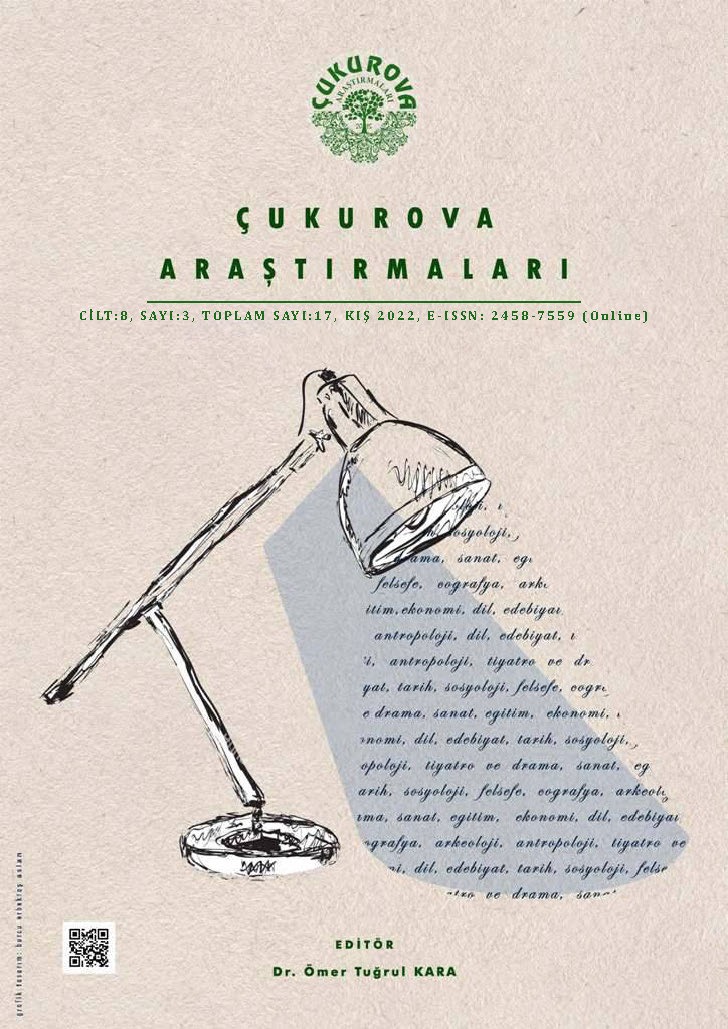TARTIŞMA PROGRAMLARINDA CİNSİYET DEĞİŞKENİNE BAĞLI SÖZ KESME OLGUSUNA YÖNELİK BİR KARŞILIKLI KONUŞMA ÇÖZÜMLEMESİ
Author :
Abstract
Karşılıklı konuşma, iletişim katılımcılarının ortak ilgi ve amaçları doğrultusunda iletişim kurmalarını sağlayan işbirlikçi bir öze sahiptir ve bu özün korunmasını sağlayan kurallar dizisini içerir. Ancak, günlük yaşamdaki karşılıklı konuşma etkinlikleri göz önüne alındığında bu etkileşimlerin her zaman işbirlikçi ve kurallı bir biçimde yapılandırılmadığını; aksine karşılıklı konuşmaların kimi zaman söz kesme gibi edimlere başvurulması yoluyla bilinçli olarak yarışçı bir biçimde gerçekleştirildiğini görmek mümkündür. İşte karşılıklı konuşmanın bu türden bir edimi içermesi, söz kesmenin iletişimdeki güç, baskınlık, denetim gibi işlevlerine işaret etmektedir. Bu çalışmada da, söz kesme ediminin bu işlevlerinden yola çıkarak ilgili edimin cinsiyet değişkeniyle olan ilişkisinin ortaya koyulması amaçlanmıştır. Bu amaç doğrultusunda, çalışmanın veri tabanını CNN Türk kanalında yayımlanan dört siyasi tartışma programı oluşturmaktadır. Bu programlar seçkili örneklem yoluyla belirlenmiştir. Her tartışma programından toplam onar dakikalık kesitler alınmış ve bu kesitler karşılıklı konuşma çözümlemesi çerçevesinde incelenmiştir. Bir programın yönetilmesinden sorumlu kişi olması nedeniyle gücü elinde tutması ve dolayısıyla daha sık söz kesmesi beklenen taraf olan moderatörlerin, cinsiyetlerine bağlı olarak katılımcılar tarafından ne sıklıkta söz kesme edimine maruz kaldıkları niteliksel ve niceliksel olarak saptanmış, bu saptama sonucunda söz kesme ediminin cinsiyet değişkeniyle yakından ilişkili olduğunu ortaya koyan bulgular elde edilmiştir. Çalışmanın sonuç bölümünde, elde edilen niteliksel ve niceliksel bulgular toplumsal cinsiyet çerçevesinde bütünleşik bir biçimde değerlendirilmiştir.
Keywords
Abstract
Conversation has a collaborative essence that enables communication participants to communicate in line with their common interests and purposes, and includes a set of rules that ensure that this essence is preserved. However, considering the conversation activities in daily life, these interactions are not always structured in a cooperative and regular way; on the contrary, it is possible to see that conversations are carried out consciously in a competitive way, sometimes by resorting to acts such as interrupting. The fact that conversation includes such an act indicates the functions of interruption in communication such as power, dominance and control. In this study, it is aimed to reveal the relationship of the related act with the gender variable, based on these functions of the act of interrupting. For this purpose, the database fort his study consists of four political discussion programs broadcast on CNN Türk . these programs were determined through selected sampling. A total of ten-minute sections were taken from each discussion program and these sections were analyzed within the framework of conversational analysis. Iwas determined qualitatively and quantitatively how often the moderators, who are expected to hold the power and therefore interrupt more frequently, are exposed to interruption by the participants, depending on their gender, as they are the person responsible for the management of a program. Findings revealing that it is closely related to the variable were obtained. In the conclusion part of the study, the qualitative and quantitative findings obtained were evaluated in an integrated manner within the framework of gender.
Keywords
- Al-Rojaie, Y. I. (2003). A discourse analysis of interruption, moderator role, and adress terms in Arab and American panel news interviews (Doktora Tezi). Oklahoma University, Oklahoma.
- Amalia, A. S. (2016). A conversation analysis of interruption in high school musical movie series. (Yüksek Lisans Tezi). Yogyakarta State University, Yogyakarta.
- Clancy, P. (1972). Analysis of a conversation. Anthropological Linguistics, 14, 78-86.
- Fei, Z. (2010). An analyisis of gender differences in interruption based on the American TV series Friends. (Yayımlanmış Tez). Kristianstad University, Sweden.
- Ferguson, N. (1977). Simultaneous speech, interruptions and dominance. British Journal of Social and Clinical Psychology, 16, 295-302.
- Holmes, J. (2013). An introduction to sociolinguistics. England: Pearson.
- Hutchby, I. ve Woffitt, R. (1998). Conversation analysis: Principles, practices and applications. England: Cambridge: Polity Press.
- James, D. ve Clarke, S. (1993). Women, men and interruptions: A critical review. D. Tannen (ed.), Gender and conversational interaction (ss. 231-280). New York: Oxford University Press.
- Jefferson, G. (2002). Is ‘no’ an acknowledgement token? Comparing American and British uses of (+)/(-) tokens. Journal of Pragmatics, 34, 1345-1383.
- Liddicoat, A. J. (2007). An introduction to conversation analysis. Londra: Continuum.
- Sacks, H., Schegloff, E.A. ve Jefferson, G. (1974). A simplest systematics for the organization of turn-taking for conversation. Language. 50, 696-735.
- Schegloff, E. A. (2000). Overlapping talk and the organization of turn-taking for conversation. Language in Society, 29, 1-63.
- Tannen, D. (1992). You just don’t understand: Women and men in conversation. London: Virago Press Limited.
- Zimmerman, D.H ve West, C. (1975). Sex roles, interruptions and silences in conversation. Thorne, B. and Henley, N. (Eds.) Language and sex: Difference and dominance. Rowely, Mass. Newbury House.
- Wooffitt, R. (2005). Conversation analysis and discourse analysis: A comperative and critical introduction. New York, NY: Sage. VERİTABANI KAYNAKÇASI
- CNNTürk TV, (23.07.2020). “Ankara Kulisi: CHP’de Kılıçdaroğlu-Cihaner Yarışacak mı? Siyasette 3. İttifak mı çıkacak?” https://www.youtube.com/watch?v=roRGNWU-RKA&t=10201s (Erişim Tarihi: )
- CNNTürk TV, (08.06.2022). “Rusya hareketta Türkiye’nin yanında mı? Harekat bölgesinde şu an kimler var? Muhalefetin erken seçim hesabı ne?” https://www.cnnturk.com/tv-cnn-turk/programlar/tarafsizbolge/rusya-harekatta-turkiyenin-yaninda-mi-harekat-bolgesinde-su-an-kimler-var-muhalefetinerken-secim-hesabi-ne-tarafsiz-bolgede-konusuldu (Erişim Tarihi: )
- CNNTürk TV, (03.06.2022). “Kılıçdaroğlu neden “Adayım” demedi? Akşener’inde mi adaylık hesabı var? Neden Münbiç, neden Tel Rıfat?” https://www.cnnturk.com/tv-cnn-turk/programlar/akilcemberi/kilicdaroglu-neden-adayim-demedi-aksenerin-de-mi-adaylik-hesabi-var-neden-munbicneden-tel-rifat-akil-cemberinde-degerlendirildi (Erişim Tarihi: )
- CNNTürk TV, (09.06.2022). “Erdoğan’ın adaylık açıklaması, İYİ Parti’nin CHP karşıtı çıkışları ve Gelir endeksli senet ihracının detayları.” https://www.cnnturk.com/tv-cnn-turk/programlar/gecegorusu/erdoganin-adaylik-aciklamasi-iyi-partinin-chp-karsiti-cikislari-ve-gelir-endeksli-senetihracinin-detaylari-gece-gorusunde-konusuldu (Erişim Tarihi: )





